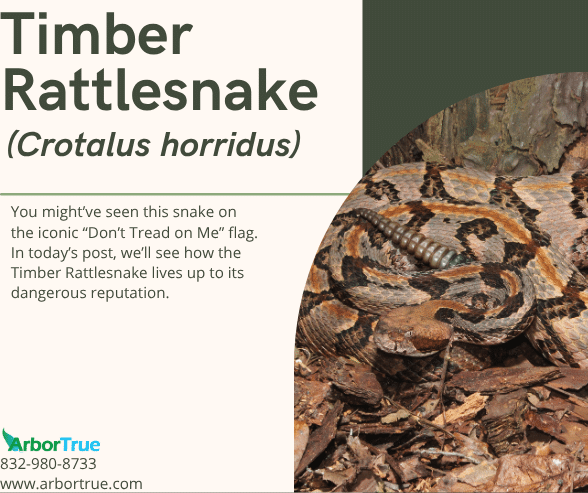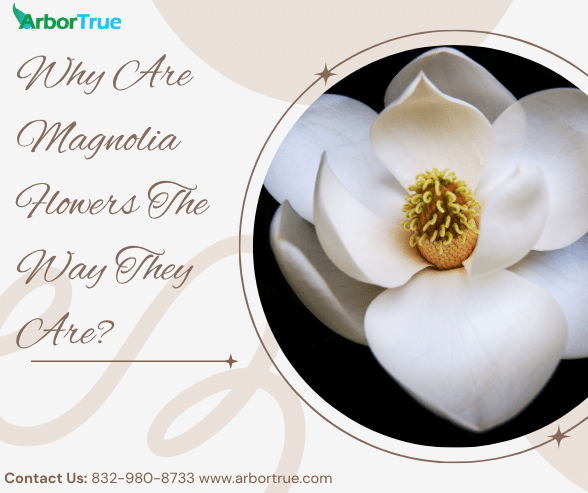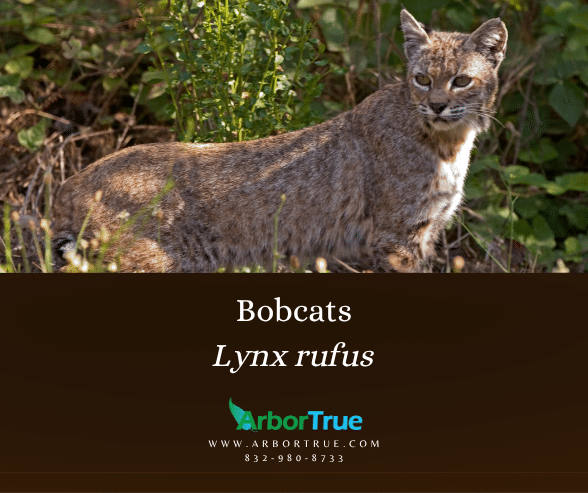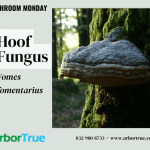
Mushroom Monday: Hoof Fungus (Fomes fomentarius)
June 23, 2025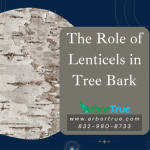
The Role of Lenticels in Tree Bark
June 27, 2025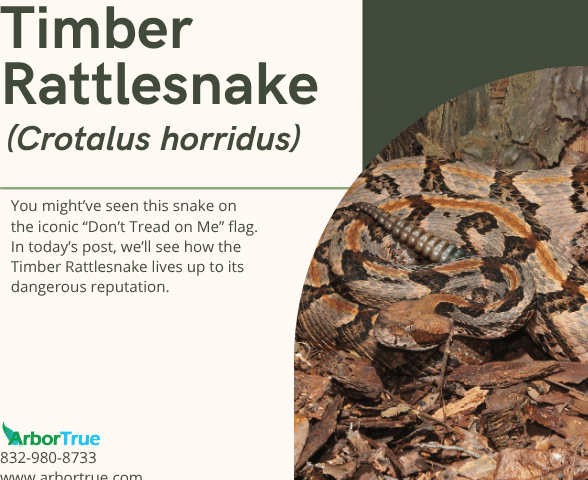
Timber Rattlesnake (Crotalus horridus)
You might’ve seen this snake on the iconic “Don’t Tread on Me” flag. In today’s post, we’ll see how the Timber Rattlesnake lives up to its dangerous reputation.
Physical Characteristics
Timber rattlesnakes (Crotalus horridus) typically measure between 36 and 60 inches in length, with a robust and heavy-bodied build. They possess broad, flattened heads and narrow necks. They also have heat-sensitive pits that allow them to detect warm prey in dim light. There are dark, V-shaped bands along their bodies, which may vary in color from yellow to gray or greenish-white. A rust-colored stripe often runs along the back. A thick rattle terminates their tails which is made up of beads formed through shedding. Moreover, their keeled scales enhance their natural camouflage among the tree roots, leaf litter, and rocky crevices.
Hunting and Diet
The prey of timber rattlesnakes typically consists of rodents, squirrels, and occasionally frogs or other small animals. They rely on their keen thermal vision, enabled by sensitive pits on their faces, to detect prey that passes nearby. As they seize their target, they inject a venom that immobilizes the prey rapidly, allowing the snake to then swallow it whole. The timber rattlesnake employs ambush tactics to catch prey. They will move through areas of foliage to find prey at rest, or stake out on a branch and catch it passing by.
Habitat
Timber rattlesnakes favor habitats that provide both concealment and opportunity for basking. They inhabit upland woods, rocky ridges, forested bluffs, and areas where abundant tree cover merges with open spaces. In these settings, fallen logs, leaf litter, and even abandoned sawdust piles create hiding spots. Additionally, these areas often offer the ideal thermal conditions necessary for regulating body temperature. During colder months, timber rattlesnakes retreat to dens nestled within rock crevices, while in the warmer seasons they emerge to bask in sunlit clearings.
Qualities and Effects of the Venom
The venom of the timber rattlesnake plays a crucial role in both predation and self-defense. When attacking prey, the snake injects venom that combines hemotoxic and neurotoxic elements, quickly incapacitating its target. This rapid immobilization allows the snake to conserve energy during feeding and ensures that struggling prey does not escape. Moreover, the venom serves as a deterrent against potential predators. Timber rattlesnakes rarely initiate conflict. Instead, they prefer to avoid detection. However, when threatened, they will employ their venom along with a rattle to discourage further harassment.
Behavior
Timber rattlesnakes generally choose to escape rather than engage in a direct confrontation. Additionally, these snakes adjust their activity patterns based on environmental conditions; they remain diurnal during cooler parts of the year and shift to nocturnal habits during the hotter summer months.
If you liked learning about timber rattlesnakes, check out our other posts on the TrueTreeTalk blog. Follow us on Facebook to keep up with these and other posts. Check out our list of blog posts grouped by topic for more to read. Also, follow us on LinkedIn for industry-related posts.
* * *
ArborTrue is a science-based tree service company in the greater Houston area. We also serve Austin and other parts of Central Texas. We provide a range of services including tree trimming, tree pruning, tree removal, tree planting, arborist consultations, and more. Call us today at 832-980-8733 (Houston) or at 512-546-3833 (Austin) or reach out to us online to schedule an appointment.
ArborTrue has a dedicated landscaping division, now serving select areas in the greater Houston region—with more locations coming soon. We specialize in organic practices, soil biology, and ecological health to help your entire landscape truly thrive. To learn more or schedule a consultation, contact us at landscape@arbortrue.com.

